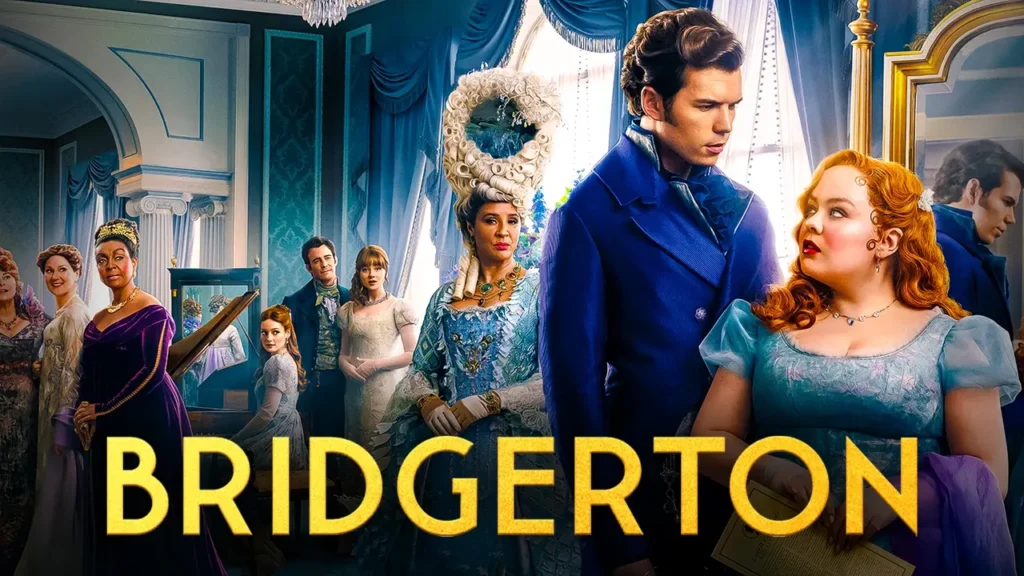The Birth of a Period Drama Phenomenon
Bridgerton emerged as Netflix’s most explosive period drama, based on Julia Quinn’s bestselling romance novels. Developed by Chris Van Dusen and produced by Shonda Rhimes under her Shondaland banner, the series debuted in December 2020 and shattered records with 82 million household views in its first month. Unlike traditional Regency-era adaptations, Bridgerton blended historical aesthetics with modern storytelling—featuring diverse casting, orchestral pop covers, and steamy romance. The show’s success lay in its bold reimagining of 19th-century London, where race, gender, and class politics intertwined with lavish balls and whispered gossip.
Bridgerton Season 1: Daphne’s Debut and the Duke’s Secret
The first season followed Daphne Bridgerton (Phoebe Dynevor), the “diamond” of the social season, as she entered the marriage market under Queen Charlotte’s (Golda Rosheuvel) watchful eye. Her fake courtship with the brooding Duke of Hastings (Regé-Jean Page) evolved into a passionate love story, complete with intimate scenes that sparked global conversations about period drama sensuality. The season’s twist—Lady Whistledown’s identity as Penelope Featherington (Nicola Coughlan)—became one of TV’s most shocking reveals. Page’s performance earned him a NAACP Image Award, while the season’s soundtrack, featuring Vitamin String Quartet’s covers of Ariana Grande and Billie Eilish, topped iTunes charts.

Bridgerton Season 2: The Viscount and the Sharma Sisters
With Page’s departure, Season 2 pivoted to Anthony Bridgerton (Jonathan Bailey) and his tumultuous romance with Kate Sharma (Simone Ashley). Inspired by Pride and Prejudice, their enemies-to-lovers arc featured electric tension, from the infamous bee sting scene to a rain-soaked confession. The introduction of Indian-British leads marked a milestone for representation in period dramas. Bailey’s portrayal of Anthony’s emotional vulnerability earned critical acclaim, while Ashley became the first woman of Indian descent to lead a major Regency-era production. The season broke its own record, becoming Netflix’s most-watched English-language series at the time.
Bridgerton – The Prequel Spin-Off
The 2023 limited series explored Queen Charlotte’s (India Amarteifio) rise to power and her marriage to King George III (Corey Mylchreest). Unlike the main series, it blended historical fact with fiction, depicting Charlotte as Britain’s first Black queen amid societal resistance. The show’s portrayal of George’s mental illness and Charlotte’s fierce loyalty added depth to the franchise. It also introduced young Violet Ledger (Connie Jenkins-Greig) and Lady Danbury (Arsema Thomas), enriching the Bridgerton universe’s backstory. The spin-off’s success proved the franchise’s ability to expand beyond the books.
Bridgerton Behind the Scenes
Bridgerton’s production design became a character itself. Costume designer Ellen Mirojnick crafted over 7,500 pieces, blending Regency silhouettes with bold colors to distinguish families—Bridgertons in blues, Featheringtons in bright florals. The show’s hair team used 4,500 wigs per season, incorporating Afro-textured styles for Black characters, a first for Regency dramas. Filming at London’s Ranger’s House and Bath’s Royal Crescent required meticulous historical research, though the show took liberties—like the now-iconic swing scene shot with hidden harnesses.
The Cast: From Breakouts to Superstardom
The ensemble cast became global icons. Nicola Coughlan (Penelope) leveraged her role into high-fashion campaigns, while Claudia Jessie (Eloise) became a feminist icon. Luke Newton (Colin) and Luke Thompson (Benedict) gained massive fan followings, with Newton set to lead Season 3. Golda Rosheuvel’s Queen Charlotte inspired Halloween costumes worldwide, and Adjoa Andoh (Lady Danbury) became a vocal advocate for diversity in period pieces. Newcomers like Charithra Chandran (Edwina Sharma) and Martins Imhangbe (Will Mondrich) used the platform to launch thriving careers.

Cultural Impact and Record-Breaking Success
Bridgerton revolutionized period dramas by normalizing diversity and female gaze cinematography. It sparked a 200% surge in Regency-era book sales and made “the ton” a pop culture lexicon. The show’s economic impact was staggering: Bath tourism rose 120%, and corset searches spiked 300%. Netflix reported the franchise generated $1 billion in value within two years, with Season 3’s teaser becoming the platform’s most-liked trailer. The “Bridgerton Effect” also saw a surge in classical covers of pop songs, with artists like Taylor Swift and BTS receiving the “Bridgerton treatment.”
Bridgerton Season 3: Penelope and Colin’s Slow-Burn Romance
The upcoming season adapts Romancing Mister Bridgerton, focusing on Penelope’s secret life as Lady Whistledown and Colin’s (Newton) growing affection for her. Set photos revealed elaborate masquerade balls and a darker aesthetic, hinting at higher stakes. Coughlan confirmed this season will explore body positivity and the pressures of societal expectations. With a two-part release (May+June 2024), Netflix aims to sustain hype, while spin-offs about Violet Bridgerton’s youth are rumored.
Why Bridgerton Dominates the Streaming Era
Bridgerton succeeded by merging escapism with progressive themes. Its orchestral soundtrack, lush visuals, and unapologetic romance offered pandemic-weary viewers a fantasy. The show’s willingness to address race (through Queen Charlotte’s “Great Experiment”) and mental health (via George III) set it apart from fluffier peers. As Netflix’s second-most valuable IP after Stranger Things, Bridgerton proves period dramas aren’t relics—they’re the future of prestige TV.
Go to main page

